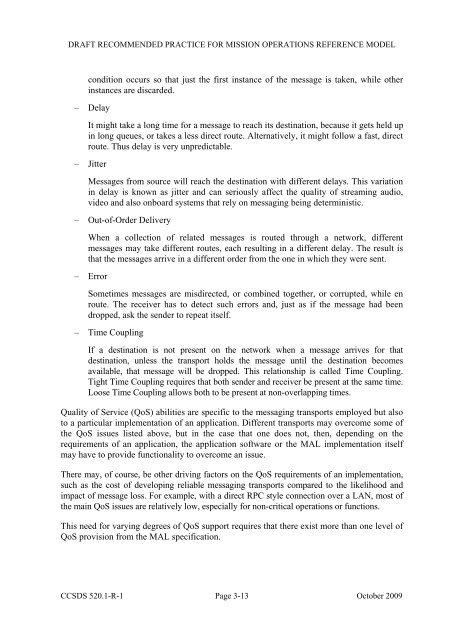Mission Operations Reference Model. Draft ... - CCSDS
Mission Operations Reference Model. Draft ... - CCSDS
Mission Operations Reference Model. Draft ... - CCSDS
Create successful ePaper yourself
Turn your PDF publications into a flip-book with our unique Google optimized e-Paper software.
DRAFT RECOMMENDED PRACTICE FOR MISSION OPERATIONS REFERENCE MODELcondition occurs so that just the first instance of the message is taken, while otherinstances are discarded.– DelayIt might take a long time for a message to reach its destination, because it gets held upin long queues, or takes a less direct route. Alternatively, it might follow a fast, directroute. Thus delay is very unpredictable.– JitterMessages from source will reach the destination with different delays. This variationin delay is known as jitter and can seriously affect the quality of streaming audio,video and also onboard systems that rely on messaging being deterministic.– Out-of-Order DeliveryWhen a collection of related messages is routed through a network, differentmessages may take different routes, each resulting in a different delay. The result isthat the messages arrive in a different order from the one in which they were sent.– ErrorSometimes messages are misdirected, or combined together, or corrupted, while enroute. The receiver has to detect such errors and, just as if the message had beendropped, ask the sender to repeat itself.– Time CouplingIf a destination is not present on the network when a message arrives for thatdestination, unless the transport holds the message until the destination becomesavailable, that message will be dropped. This relationship is called Time Coupling.Tight Time Coupling requires that both sender and receiver be present at the same time.Loose Time Coupling allows both to be present at non-overlapping times.Quality of Service (QoS) abilities are specific to the messaging transports employed but alsoto a particular implementation of an application. Different transports may overcome some ofthe QoS issues listed above, but in the case that one does not, then, depending on therequirements of an application, the application software or the MAL implementation itselfmay have to provide functionality to overcome an issue.There may, of course, be other driving factors on the QoS requirements of an implementation,such as the cost of developing reliable messaging transports compared to the likelihood andimpact of message loss. For example, with a direct RPC style connection over a LAN, most ofthe main QoS issues are relatively low, especially for non-critical operations or functions.This need for varying degrees of QoS support requires that there exist more than one level ofQoS provision from the MAL specification.<strong>CCSDS</strong> 520.1-R-1 Page 3-13 October 2009
















